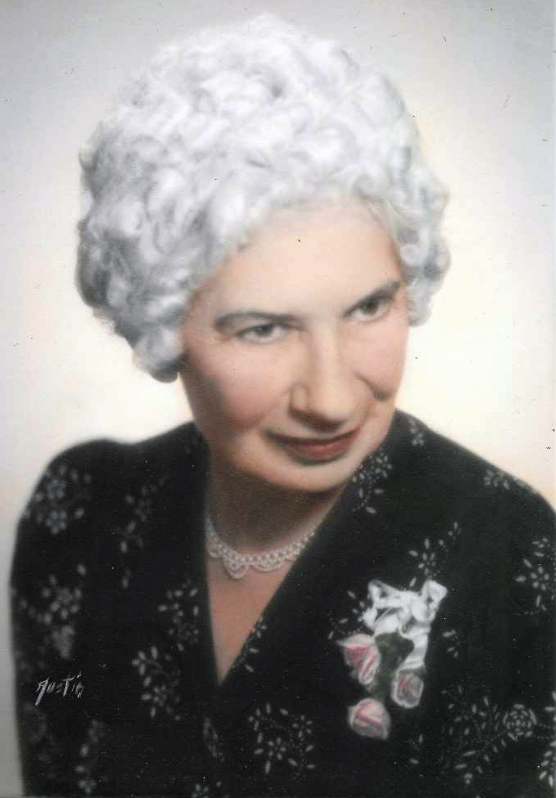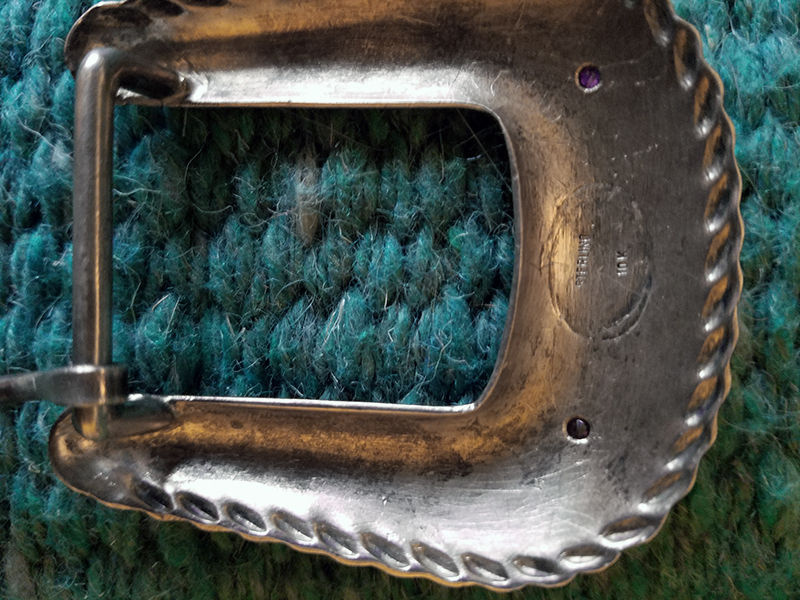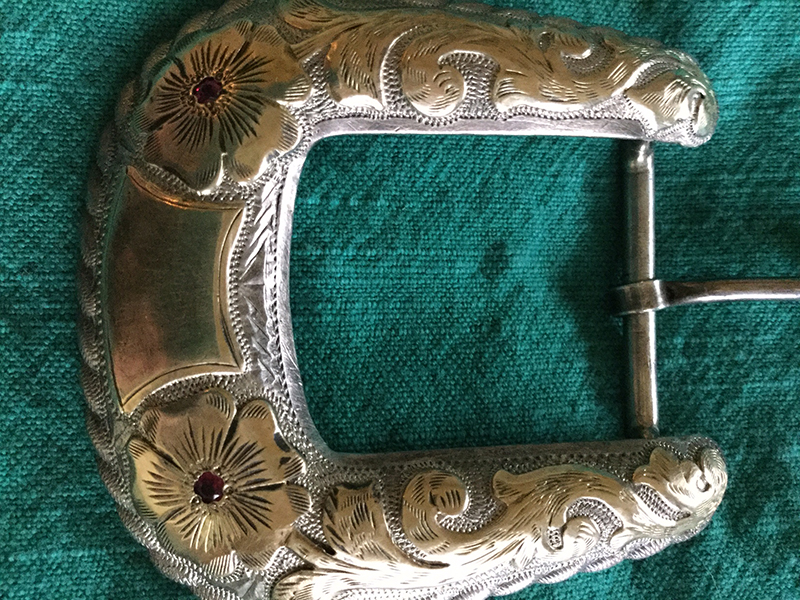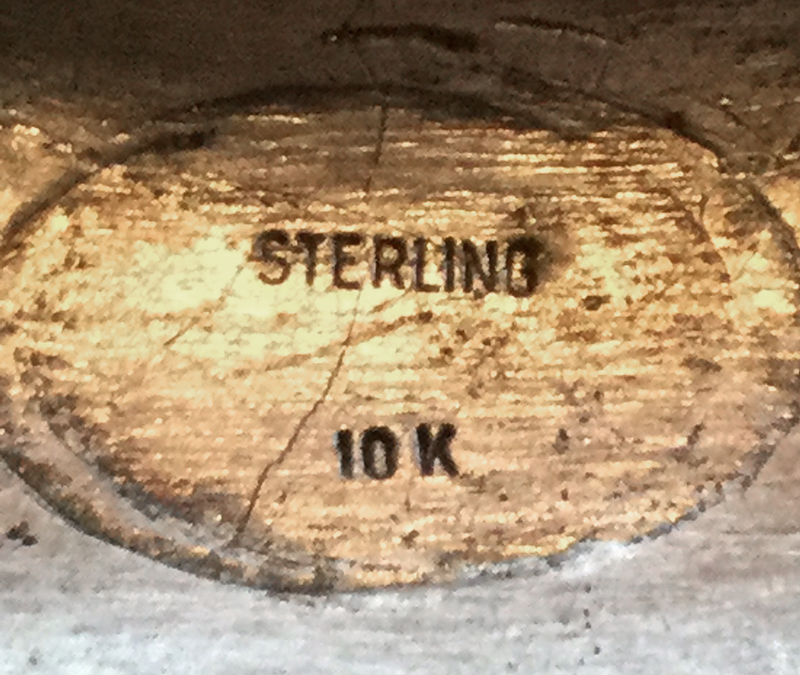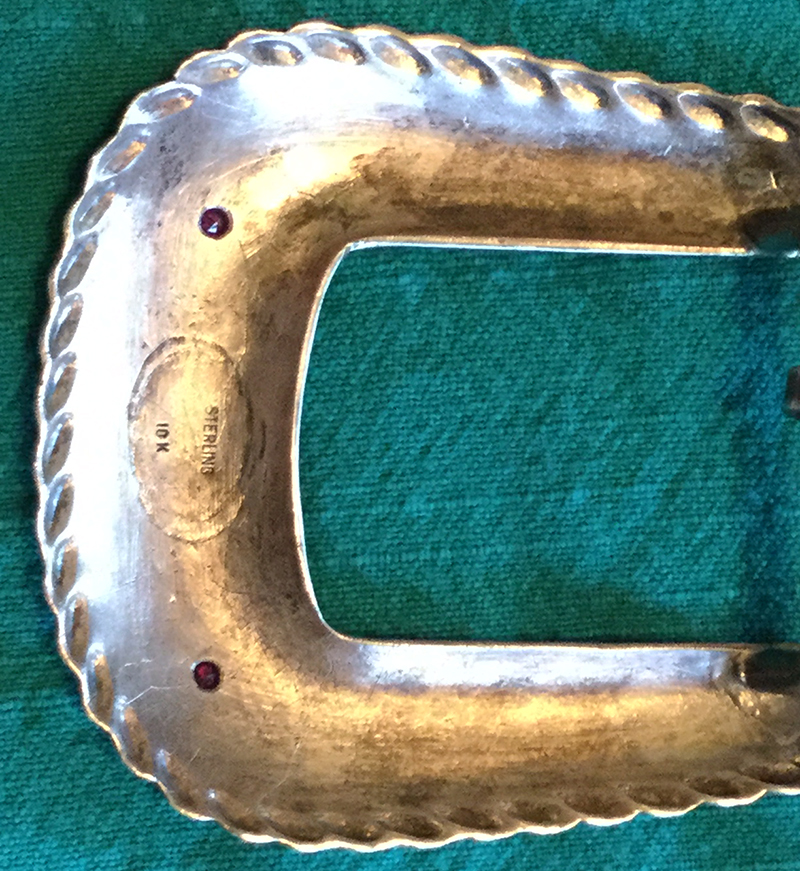|
|

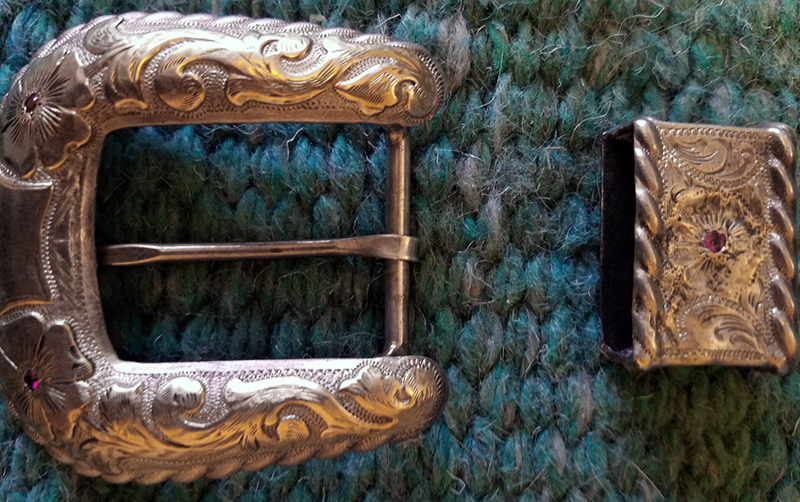
Click each image for original jpeg
Ruby-inlaid 10-karat gold and silver belt buckle salvaged from Melody Ranch after the wildfire of August 28,1962, that burned down Gene Autry's Western town. The belt keeper is somewhat melted. The unconfirmed story is that that the buckle had been given to Autry (1907-1998) by actor Buck Jones (1891-1942). The buckle is one of several items salvaged by Glenn McKinney, a Newhall contractor who, according to his daughter and son-in-law (pers. comm. 2017), received salvage rights from Autry as part of his compensation for his excavation and cleanup work after the fire. "I had always planned to erect a Western museum there (at Melody Ranch)," Autry wrote in 1995, "but priceless Indian relics and a collection of rare guns, including a set used by Billy the Kid, went up in smoke." Turns out, the fire missed a few things. The salvaged items are in the collection of McKinney's daughter, Kathy McKinney Baxter (Hart High Class of 1971), and her husband Jim Baxter (Hart Class of 1969). Now longtime residents of Idaho, Jim and Kathy Baxter are the authors of the forthcoming historical novel, "The Gold of Ghost Canyon," whose main character was the real-life friend of Kathy's father — the enigmatic gold miner Annie Lydia Rose Briggs (1883-1972), whose true story is intertwined with the Lost Padre Mine. The Clovis Argus newspaper tells the story in its report of Oct. 7, 1927, on the mine's supposed rediscovery:
It was Dr. B.F. Bragg, of Kentucky and friend of Lucky Baldwin's, who in 1876 came to Arcadia with a bunch of thoroughbreds from the Blue Grass country to sell them to the owner of the Santa Anita rancho. It was while Dr. Bragg was in Arcadia that he was approached by an Indian who wanted a horse but had no money to pay for it. He told Dr. Bragg that in return for a mount he would show him where the "Lost Padre" mine was. The mine had been, according to the story, located in 1840 by an Indian and worked by the mission fathers, who in three years, according to the legend, took out a cool million in gold. But one day the tunnel caved in, burying fifteen Indians, and the rest refused to go back. So the padres filled up the tunnel and concealed the entrance to the mine, which remained "lost" until the doctor made the deal with the Indian 24 years later. The property was re-located and it is declared Dr. Bragg and his associates took out $750,000 in two years. But death again followed the footsteps of the miners, for an Irish foreman went amuck, killed four men and flung their bodies into the shaft. Dr. Bragg escaped, but the mine was somehow "lost" again. Just before his death Dr. Bragg told Miss Annie L. Rose, now owner of the property, where the mine could be located. After many disappointments, Miss Rose and B.E. Miller of Pomona succeeded, as they believe, in locating for a third time the missing mine...
The Clovis Argus puts the mine "southeast of Sandberg's on the Ridge Route." Coming north on the Ridge Route from Castaic there was a turnoff to the right, Jim Baxter said. Annie's property was the old Kelly Ranch on the Ridge Route (ibid.). Bedrock mortars still extant on the site of the old Kelly Ranch (webmaster's observation), along with numerous numerous local stories of looted burial sites, make it the likely location of the pre-1811 Tataviam Indian village of Cuecchao. Glenn McKinney (1926-1999) was 24 years old and Annie Rose Briggs was an elderly woman in 1951 when McKinney was hired to perform excavation work at her mine. The two developed a lifelong friendship, Jim Baxter said. Annie left behind quite a bit of poetry and other writing, and McKinney preserved his experiences at the mine in 1966 on a reel-to-reel tape recording. (By that time, McKinney had become a popular driver at the Saugus racetrack.) According to Ridge Route historian Harrison Scott, Frank Knapp bought the Kelly Ranch in 1962, and it became the Knapp Ranch. A non-believer, Harrison Scott (2002) writes (pp. 131-134):
There are several old gold mines south of the ranch in Bear Canyon, the largest mine being the Gillette Mine. King Gillette of razor fortune was looking for the Los Padres [aka Lost Padre] Gold Mine. ... Gillette brought a bulldozer to Bear Canyon and ploughed up [an Indian graveyard] looking for the mine. He never found it. After Frank [Knapp] purchased the old Kelly Ranch, Annie Rose Briggs befriended him. She was a colorful character and was known to have hitchhiked up and down the Ridge Route. She lived somewhere down in Castaic and was married to Adrian Briggs [sic; s/b Franklin Adrian Briggs] who worked for the Newhall Refinery. Annie dressed in work clothes and would walk up Castaic Canyon to the Ranch. Annie was into gold mines and selling gold mine maps. After Gillette left, Annie filed claim to Gillette's old mine. ... She and Frank at one time tried to locate the old Los Padre Mine. They dug around, digging up Indian bones, but never located the mine. Annie's father was William B. Rose, who in 1875 settled on land known as Rancho Canoa, which had been a vaquero camp of the short-lived 1853 Sebastian Indian Reservation on the north side of the Grapevine under the watchful eye of the U.S. Army's Fort Tejon. Rose built an adobe stage station there, on the site of an earlier Overland Mail way station, and Rose Station became a stockmen's headquarters, post office and polling place. At some point, Rose sold his land to Edward F. Beale; Rose then moved down to Castaic, where he wound up on the Chormicle side of the Chormicle-Jenkins feud. William's son William Jr., Annie's brother, is the Billy Rose who shot William Jenkins from his horse in 1913. The horse reportedly died. Jenkins lived another three years, succumbing to kidney disease at age 81. There should be a novel or two in there. About the 1962 Fire The first blaze broke out just after noon in Hasley Canyon, north of Castaic Junction. The second broke out an hour later near the Circle J Ranch between Newhall and Saugus. High winds whipped the flames into the most intense inferno anyone had ever seen. When the smoke cleared three days later, 17,200 acres had been scorched and 15 structures and numerous out-buildings were lost. No one was killed, but the Western street at Melody Ranch was gone. "I had always planned to erect a Western museum there," Autry remembered in 1995, "but priceless Indian relics and a collection of rare guns, including a set used by Billy the Kid, went up in smoke. Thank God, the ranch hands and all 14 of our horses were uninjured." Further Reading: 800 TB Patients Flee Fire; Homes, Autry Ranch Razed (AP 8-29-1962) My Memories Of Melody Ranch by Gene Autry, 1995 Melody Ranch: Movie Magic in Placerita Canyon
JK6201: Original jpegs courtesy of Jim and Kathy McKinney Baxter. Online images only.
|
• AP Full Story
Melody 8-28-1962
Oil Tank 8-28-1962
SFV (Mult.)
Man Flees 8-28-1962
Melody 8-29-1962
Olive View: Aftermath 1962
Salvaged Buckle
Salvaged Whip
Salvaged Conchos
Salvaged Curb Bit
Salvaged Iron
|
The site owner makes no assertions as to ownership of any original copyrights to digitized images. However, these images are intended for Personal or Research use only. Any other kind of use, including but not limited to commercial or scholarly publication in any medium or format, public exhibition, or use online or in a web site, may be subject to additional restrictions including but not limited to the copyrights held by parties other than the site owner. USERS ARE SOLELY RESPONSIBLE for determining the existence of such rights and for obtaining any permissions and/or paying associated fees necessary for the proposed use.
